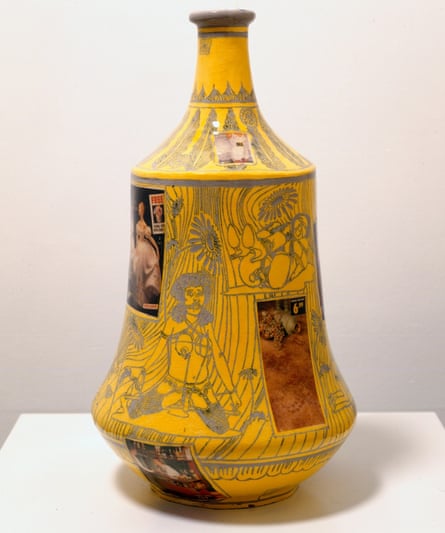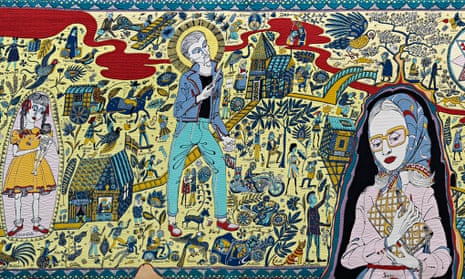Grayson Perry would be a very good artist if he never made any art. As a performer on a public stage, he is brilliant. His prickly persona is a work of art in itself. At pure conceptualism, he is great. What a shame that he insists on making stuff.
Just when his conceptual career is at its height – with his crazy witch house opening its doors in Essex – here comes an exhibition not of Perry, but his pots. Provincial Punk at Margate’s Turner Contemporary is a thorough survey of Perry’s craft objects, from ceramics to prints and tapestries – an exploration of his making, in all its mediocrity.
In time, the stuff here will overcome the fame he has now, its ordinariness making future generations wonder what all the fuss was about. As physical, sensual works of art, his pieces have all the vibrancy of a laborious Victorian oil painting of a dog loyally attending its master’s grave, or a child blowing soap bubbles.

Perry might enjoy that kitsch historical comparison, for he loves to mimic old English styles. If you think his pottery is badly made, you should see some of the folk art that’s tucked away in museums; he obviously has seen it, and mimics it. But there’s no magical transformation of the material. The endless quotations from cultural history in Perry’s art are predictable and glib. His take on contemporary society is shrill, repetitive and ultimately meaningless.
The stupidity of his ceramics really takes the Staffordshire biscuit box. Perry’s pots start with a cliched image of traditional ceramics as genteel bourgeois decor, then go about “subverting” this straw man with collaged pictures of council estates, angry kids and swearwords. One is annoying; a roomful becomes cacophonous. Walking among all the strident phrases and thinly drawn faces, I felt as if I was trapped in one of those parties drawn by Michael Heath where lots of trendy folk are talking bollocks.
But wait, there’s more. When Grayson Perry was creating his early pottery in the 1980s, the exhibition reverently informs us, he also made Super 8 films. Here they are, lovingly restored. And very silly. So here he was in the 1980s, part of an avant garde group around the film-maker Derek Jarman, shooting eccentric little films, and making craft objects such as his mock-Saxon Early English Motorcycle Helmet. But then British art exploded: a generation of conceptual artists led by Damien Hirst made art that was all idea, no craft. Their vitrines and casts set the stage for a backlash when craft would come back into fashion, courtesy of the superficial marketing logic our art seems reduced to.

Charles Saatchi – who else – set the style in his 2001 exhibition, New Labour, which promoted Perry’s pots. The Turner prize duly followed and Perry has made better use of it than any other winner, turning himself into part of the national furniture. But two wrongs don’t make a right, and Damien Hirst does not justify Grayson Perry. The handicraft skills Perry possesses are fussy and uninspired.
Here are his prints inspired by German art, with some nice details of old houses and blasted trees that are drowned out by the obsessive “relevance”. For once I would like to see Perry please himself with a work of art that is not about anything and not relevant to anything – something private. For it is privacy and silence that I miss in his work. Real art has mystery and otherness. It cannot be put into words. Instead, Perry makes slogans. He can and does explain everything he is doing. It is all a “statement”.
This is art for those who need to be told what they are looking at and why it matters. No, that’s not fair. People are so busy these days. Art is not that big a part of most people’s lives. An artist who can deliver something quickly understandable and explain it 10 times over is doing the distracted modern audience a favour. Grayson Perry is really made for this age; perhaps his epically empty tapestries are all we deserve.

Comments (…)
Sign in or create your Guardian account to join the discussion